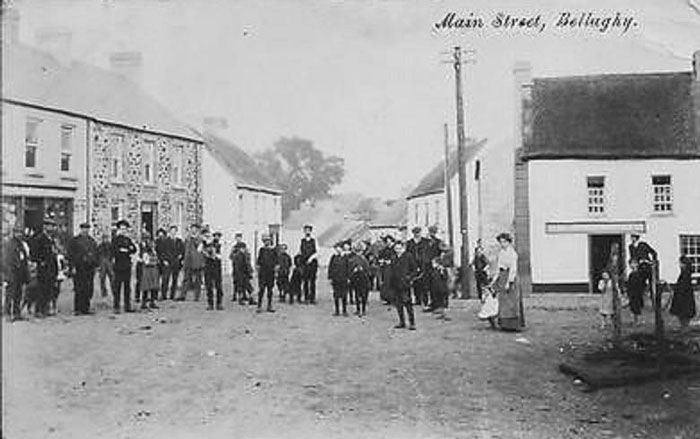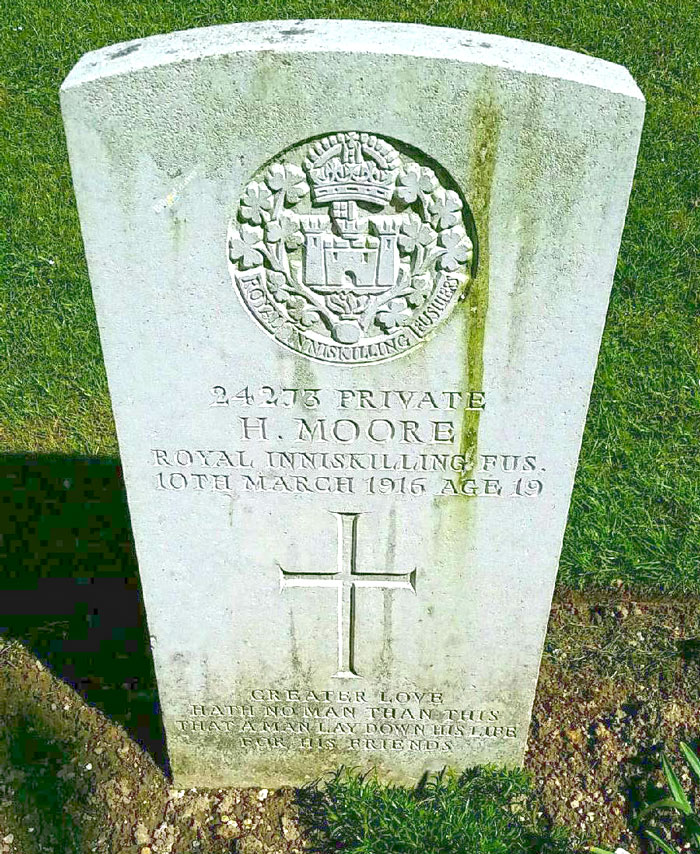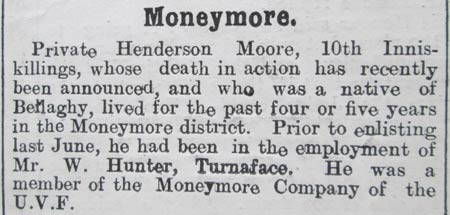| Date |
Information |
|
| 01/05/2020 |
02244 |
| 17/09/2018 |
 |
| 17/09/2018 |
Private Henderson Moore is buried in Authuile Military Cemetery, France. |
| 17/09/2018 |
 |
| 28/11/2016 |
In a letter to Rev Thomas McCrea, Bellaghy, County Derry, Rev J Jackson Wright, B.A., chaplain with the Ulster Division, writes:- ‘I am sorry to inform you that H Moore, from Ballymacombs, was killed on Friday night by shrapnel. I shall be grateful if you will tell his relatives how sorry we are to lose him. He was an exceedingly good soldier and a great favourite of his comrades.’ Private Henderson Moore is the first of the South Derry Volunteers to be killed. |
| 28/11/2016 |
 |
| 28/11/2016 |
From the Belfast Newsletter dated 25th March 1916: |
| 30/12/2015 |
The 1901 census records Henderson as age 4 at living with the family at house 5 in Tamlaght Duff, Bellaghy. His father was an agricultural labourer and his mother was a linen weaver. |
| 30/12/2015 |
Rev J Jackson Wright, B.A., chaplain with the Ulster Division, has written to Rev T McCrea, Bellaghy, in regard to the death of Private Henderson Moore, 10th Inniskillings. Mr Wright states:- |
| 30/12/2015 |
 |
| 30/12/2015 |
From the Mid Ulster Mail dated Saturday 25th March 1916: Private Henderson Moore, Ballymacombs |
| 30/12/2015 |
Soon after Henderson Moore’s death, the Reverend J. Jackson Wright, B.A., Chaplain to the 36th Ulster Division, wrote a letter to the Reverend T. McCrea of Bellaghy, explaining the circumstances of Private Moore’s death and extended sympathy to his family. |
| 30/12/2015 |
‘I am sorry to inform you that H Moore, from Ballymacombs, was killed on Friday night by shrapnel. I shall be grateful if you will tell his relatives how sorry we are to lose him. He was an exceedingly good soldier and a great favourite of his comrades. His officer speaks in the highest terms of his quiet steady disposition and ready willingness for his duties, The funeral was on Saturday evening, and along with four comrades, he lies in a cemetery reserved for British troops. We had a simple service at the graveside, and it may be some consolation to his relatives to know that his death was instantaneous and the internment was sadly and reverently done.’ |
| 30/12/2015 |
Family: William Moore, Margaret Moore, Margaret Moore (born 14th July 1890), Isabella Moore (born 16th June 1892), Andrew Moore (born 9th January 1894), Henderson Moore (17th May 1896), Mary Moore (born 14th April 1898), William Moore (born 5th November 1901), Hessie Jane Moore (born 13th April 1904). |
| 30/12/2015 |
Private Henderson Moore was struck by shell shrapnel on 10th March 1916. His death was instantaneous. Henderson was 19 years old. |
| 30/12/2015 |
Henderson Moore lived and worked in Moneymore for Mr. W. Hunter at Turnaface from around 1910. |
| 30/12/2015 |
By the time of the 1911 census Henderson no longer lived with the family. |
| 30/12/2015 |
Henderson Moore enlisted in June 1915 in Moneymore with the 10th Battalion Royal of the Royal Inniskilling Fusiliers. |
| 30/12/2015 |
Henderson Moore was the son of William and Margaret Moore. Henderson was born on 17th May 1896 in Bellaghy, County Londonderry. |
| 30/12/2015 |
The enemy bombardment lifted at 1.30 am the next morning. 7 men of the 10th Inniskillings were killed in action or died of wounds as a result of this attack. |
| 30/12/2015 |
He was buried on Saturday evening of 11th March in Authuile Military Cemetery, France, along with four comrades. |
| 30/12/2015 |
The CWGC record Private Henderson Moore as the son of William Moore. |
| 30/12/2015 |
From the Mid Ulster Mail dated Saturday 1st April 1916: |
| 30/12/2015 |
 |
| 30/12/2015 |
Private Henderson Moore, 10th Inniskillings, whose death in action has recently been announced, and who was a native of Bellaghy, lived for the past four or five years in the Moneymore district. Prior to enlisting last June, he had been in the employment of Mr W Hunter, Turnaface. He was a member of the Moneymore Company of the U.V.F. |
| 30/12/2015 |
On the cold Friday morning of March 10th 1916, the 10th Inniskillings were posted at Thiepval Wood. Some of the men were posted to ‘saps’ which were small dugouts, well camouflaged just beyond their front line trench. The enemy had spotted movement early that day and had trained their mortars and artillery on the Inniskilling positions. In the afternoon the 10th Battalion was strafed with shells and again later in the day. |